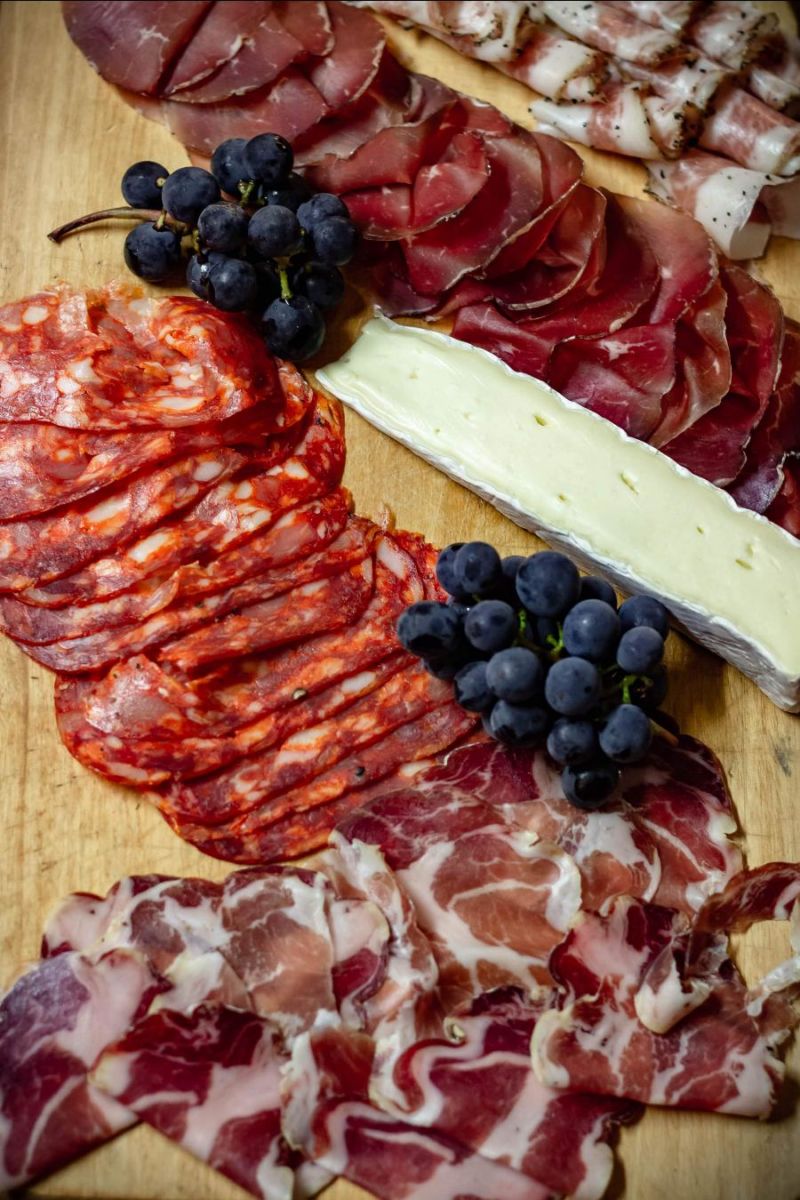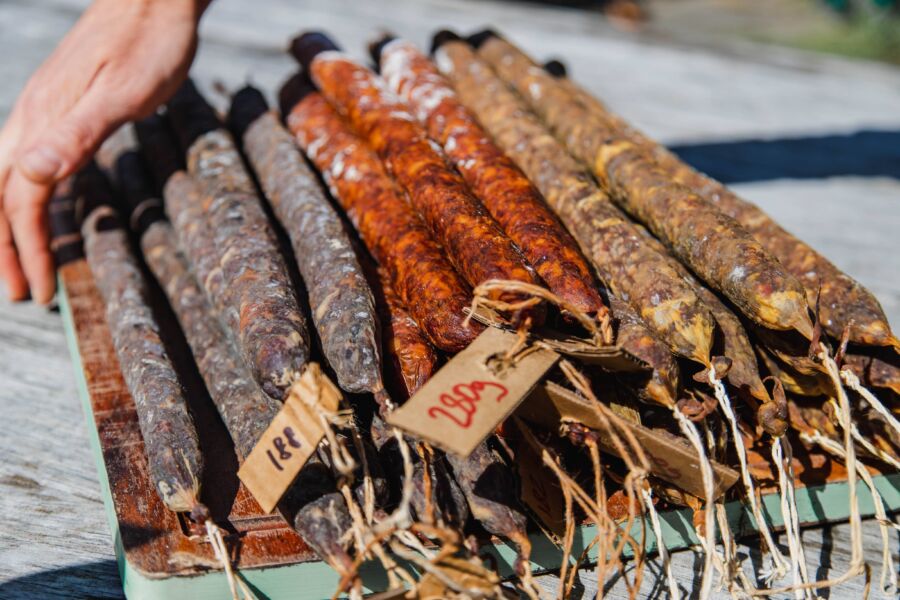Salamis vary a lot, and the best ones to put on a charcuterie or antipasti board will of course, depend on what you want to savor.
After exploring, making, and trying salamis for 20-odd years, I’ve got a few trips and tricks to share with you.
If you’ve ever plucked a piece of salami off a charcuterie board, you were probably tempted to snap a picture of the masterpiece.
Charcuterie is the pinnacle of effortless entertaining and might be the most amazing sensory experience of practically any appetizer.
Since charcuterie is my greatest passion, a constructed or deconstructed charcuterie board means a lot to me!
Almost every home entertaining event nowadays involves a meat and cheese appetizer, but do you know which salami to choose if you want to make your charcuterie board?
The best salamis for a charcuterie board are sopressatta, genoa, pepperoni, feline and calabrese salamis. Or other quality dry-cured salamis.
Quality dry-cured salami can be thinly sliced and is ideal for charcuterie boards. A great charcuterie platter combines taste, texture, and flavor. Choose artisanal salami meats that complement each other well, with flavors ranging from simple to complex.
Putting together a charcuterie board is a lot of fun. It’s all about balance, so make sure your components are of great quality and complement one another while still being able to stand alone. The steps below will show you how to select the best salami for your charcuterie board.
My advice is don’t think more is better, less is better – and savor quality over volume. Bigger is better is not how we roll around here.
Here is a simple charcuterie/antipasti board I put together in the mountain of Tuscany, foraging for porcini and admiring 500-year-old chestnut trees!

So, the above is only one salami, but the point is to show you the most straightforward approach I love!
Unique and Contrasting Salami for a Charcuterie Board
Here is the table from subtle to intensive flavors to help you out:
| Salami Type | Flavor Intensity | Main Ingredients |
|---|---|---|
| Genoa Salami | Medium | Pork, red wine, black peppercorns |
| Saucisson Sec | Subtle | Pork, garlic, black peppercorns |
| Milano Salami | Medium | Pork, garlic, white wine |
| Truffle Salami | Intense | Pork, black truffle, truffle oil (maybe) |
| Blueberry and Merlot | Subtle | Pork, blueberries, Merlot |
| Fennel Salami | Medium | Pork, fennel seeds, red wine |
| Spanish Chorizo | Intense | Pork, paprika, garlic |
| Picante Salami | Intense | Pork, red pepper, chili |
| Pepperoni | Subtle | Pork, paprika, red pepper |
| Cacciatore Salami | Medium | Pork, black pepper, red wine |
| Fast Fermented Salami | Subtle | Pork, spices, and garlic |
| Summer Sausage | Subtle | Beef, pork, and spices |
| Borenmetworst | Medium | Pork, beef, and spices |
You will find many Western, Central, and Eastern European varieties of classic salami that are subtle or medium-flavored.
The further you get to the spice trade areas of the world, such as Southern Italy, the spice aspects of history will showcase itself.
The United States has quite a new age variation of flavors as well as the classics replicated by many quality companies.
Cured meats provide salt and a savory taste to your meal, making them a perfect starting point. Here are a few things to keep in mind when picking the salamis you will add to your charcuterie board:
- Flavor: Consider a combination of savory, salty, smoky, herbal, and spicy tastes.
- Meat: Choose 3 to 5 different types of meat, including pork, beef, poultry, lamb, and venison. (Most Italian classics are pork-based; go local and sustainable if possible)
- Texture: Consider mixing tender, thinly sliced meats that are easy to roll or stack and hard salami variations with a chewy-hearty flavor.
- Origin: Is best for the planet
Make sure that each element contributes something unique to the board. The best charcuterie platters include acid, salt, fat, sweetness, and umami. All of these factors should be present in order to achieve a balance on the palate.

Ok so maybe they aren’t a must-have, but they are worth talking about in detail! There are thousands of variations. I’ve always found decent salamis at food markets, but it depends on where you live.
A lot of these artisanal slow food salamis take 3-6 months to make or dry to a point of dense flavor and drying enough to create a sensory experience whilst also preserving the salami to some degree.
Remember, the key to a successful charcuterie meat board is to blend taste, texture, and flavor. Curled meats that can be thinly sliced or coiled when created from paper-thin slices are ideal for charcuterie boards (here is what to do with leftover charcuterie meats).
Soppressata, genoa salami, calabrese, and hard pepperoni are some of the most popular cured meats. We’ll take a deeper look at each one below so you can get an idea of which will work best on your board.
Some classics:
Soppressata
Soppressata is a kind of Italian salami made primarily of pork. Many types of soppressata have stringent requirements about where the pig comes from, what part of the pig meat is utilized, and how and where it is prepared.
(Not in some regions of Italy Sopressata is a offal based product)
Soppressata salami is coarser ground than other types of salami. It has a solid, somewhat chewy texture and a taste similar to pepperoni. In terms of look, it’s a dark crimson hue with huge lumps of fat scattered throughout.
This salami (I wrote about sugar and carbs in salami also) tastes best when cut into tiny, circular pieces.
Genoa Salami
Genoa salami receives its name from the Genoa region of Italy, where it is thought to have originated. It is mainly comprised of pork, although it can also contain veal or beef (I wrote about charcuterie that is not pork here). It is produced by blending pork meat, fat, red wine, peppercorn, and spices. It’s ground up uncooked, blended with the other ingredients, and then placed in a casing to dry and age.
The color of Genoa salami is more subdued than that of other salamis. Because of the increased fat content, it is more prominent than pepperoni and softer and greasier than other salamis. Genoa salami (all salami is ready to eat) has a unique flavor with notes of bright acidity.
Genoa salami comes in a variety of thicknesses. It is a typical salami (different salami suit different pizza styles too, I wrote about this here) that is offered pre-cut and pre-packaged for convenience. It’s also available sliced at the deli counter.
Calabrese
Calabrese is a kind of Italian salami from the south of Italy. It is mainly produced from pork and comes in two varieties: dolce and Picante. Calabrese dolce is a mild salami seasoned with salt, pepper, and wine. Calabrese Picante is a spicy salami seasoned with red pepper flakes or Calabrian paprika.
Calabrese salami (cut and whole salami storage is also different) is more profound in color than other types of salami. Because it is a coarse ground salami, it also appears to have more pieces of fat than other versions. It might be somewhat tart from the wine or spicy and fiery from the red peppers, depending on the kind of Calabrese.
Calabrese is often served in circular, thin slices. You don’t want it to be so thick that it overpowers the other tastes on the plate.
Pepperoni
Pepperoni is a dried, cured, seasoned beef and pork sausage. This salami (I’ve written about some of the interesting salami for pasta salad here) is neither too coarse nor too fine. The meat is ground then seasoned with salt, sugar, and spices such as paprika and garlic powder. The mixture is then filled and cured in sausage casings.
Pepperoni has a salty, spicy, tangy flavor because it is cured with salt, spices, and lactic acid. Because of the chewy texture, it is frequently sliced into thin, circular slices. Whole pepperoni sticks may be found in the meat and deli area of most supermarkets, as well as specialized meat shops and butcher shops.
Bottom Line
You should now have a better sense of which salami to add to your charcuterie board. The beauty of a charcuterie board is its adaptability and the fact that meat and cheese are always in season, so they are perfect for entertaining year-round.
If you can, all you should look for is the passion behind the product, whether its salami or anything else for that matter.
Find the passion; you will find the quality more often than not.

Tom Mueller
For decades, immersed in studying, working, learning, and teaching the craft of meat curing, sharing the passion and showcasing the world of charcuterie and smoked meat. Read More
